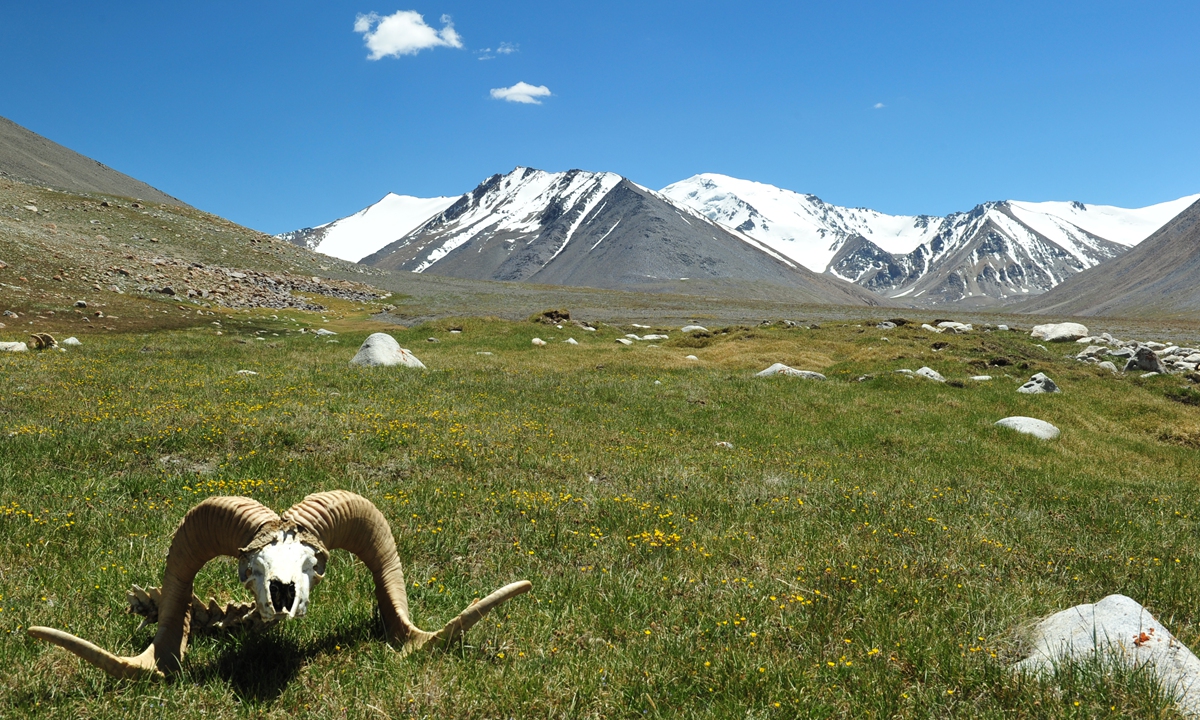ARTS / BOOKS
New book restores ancient Silk Road’s routes, limning the outreaching Chinese civilization
A modern pilgrimage

A scenic spot close to the Pamir Plateau Photo: Courtesy of Song Lai
If it weren't for seeing the sublime beauty of the Pamir Plateau with his own eyes, Chinese author Hou Yangfang would not have been as committed to publishing his latest book This is the Silk Road.The book condenses Hou's decade-long journey across key spots along the ancient Silk Road landscapes like the Lop Nur in Northwest China's Xinjiang Uygur Autonomous Region. He was blown away by the site's beauty, as was German geographer Ferdinand von Richthofen a century before him. At the time, Richthofen identified the exact location of the Lop Nur and later coined the term "Silk Road" used to this day.
Paying tribute to this Western explorer in an early chapter of his book, Hou's work neither focuses on Richthofen's story nor his personal travel anecdotes. His goals are to clarify the ancient Silk Road's routes and show the domestically developed cultural explorative spirit through historical figures like Han Dynasty (206BC-AD220) envoy Zhang Qian.
Turn a noun into a verb
Hou embarked on his ancient Silk Road journey in 2012, with one reason in mind. He told the Global Times that he thought the ancient Silk Road is often understood by many as an "overly generalized noun" and there was still room for him to show the readers the constituent parts of the famed Silk Road.

Author Hou Yangfang Photo: Courtesy of Song Lai
"Camels walking in the desert might be how we depict the Silk Road. When saying 'a visit to the Silk Road,' many of us might only associate it with hot tourist spots such as Dunhuang and Xi'an. Those are not enough for us to fully understand it," Hou stressed.Unlike much of the previous text-based research on the ancient Silk Road, Hou's ambition to depict its fuller image has been facilitated through on-site travels spanning over 30,000 kilometers over the years. It was his take on turning the "noun" into a "verb"; to turn the "study of the Silk Road" into "studying the Silk Road."
His destinations cover Chinese sites like the Hexi Corridor, a narrow isthmus that extends the ancient Silk Road into Central Asia, the southern and northern parts of Xinjiang where Zhang Qian, which Hou explored on his travels to West, as well as Xi'an in Shaanxi Province, commonly seen as the starting point of the ancient Silk Road.
The author knows all too well about the "exchanging" essence of this remarkable historical path, extending his journey beyond China's borders to five countries in Central Asia, including Kazakhstan and Uzbekistan, where Chinese inventions like "papermaking and irrigation technology" were traded in exchange for "exotic artifacts and arts," historian Xue Liming, told the Global Times.
The author's vast experiences have been condensed into five chapters of the book. Aside from giving detailed explanations on how such sites are connected, This is the Silk Road's anecdotes offer readers captivating insights.
Hou told a story about how ancient Greek sculptural art may have inspired the creation of the Qin Dynasty (221-206 BC) Terracotta Warriors.
As part of missionary work, ancient Greek sculptors were once hired by the Kushan Empire, a thriving regime in Central Asia at the time. Greek artisans' interpretations of Buddhist sculptures later earned the title Gandhara art. The art form then traveled through the ancient Silk Road back to China and inspired Chinese sculptures. It also explains why the helmet on the Terracotta Warriors' heads appears to be similar to those depicted in Greek art.
Another anecdote about Zhang Qian was of his furthest-flung travels to present-day's Afghanistan, making history as the first Chinese person to witness a Mediterranean cultural oasis in the middle of Central Asia.
"I guess Zhang was stunned to find splendid palaces and not yellow sand desert, along with bathing ponds and theaters when he arrived in Central Asia," Hou told the Global Times.
History for all
Stories like the "Terracotta Warriors sculptures" were only drops in the bucket when compared to the flood of information and insight that in Hou's book. Other examples like the "rebellious monk Xuanzang" attempt to show the ancient Silk Road as a melting pot of different civilizations like Chinese, Mediterranean, South Asian and Persian.
Despite being in good scholarly company, Hou stands out in his attempt to study the culture through a digital technological design called the "Silk Road GIS." GIS is a geographic information system that borrows modern GPS's functions of identifying location and trajectories.
Hou and his team have uploaded collected photos and landmark coordinates onto the system, allowing it to create a visualizer for ancient Silk Road routes in different time periods like the Han, Sui (581-618) and Tang (618-907) dynasties for prospective readers. Aside from research purposes, GIS-generated data is accessible to the public for free.
"The culture belongs not only to academia, but also to everyone of us," Hou said.
Conducive to China's Belt and Road Initiative (BRI), which was inspired by the ancient Silk Road, numerous sites on the ancient path have been given new functions just like the transformation of the Hexi Corridor from a spice route to the China-Europe Railway Express gateway.
Such a change stays true to the ancient Silk Road's spirit of merging cultures, while giving rise to a new purpose by revealing modern China's dedication to merging cultures by valuing global cooperation and diversity.
The BRI, a "contemporary Silk Road" that could be the inspiration to Hou's next project has attracted international researchers just like British historian Peter Frankopan predicted when he described the Silk Road as an "integral part of how China sees the world, preparing for the future."
The article is contributed by Yu Wende



